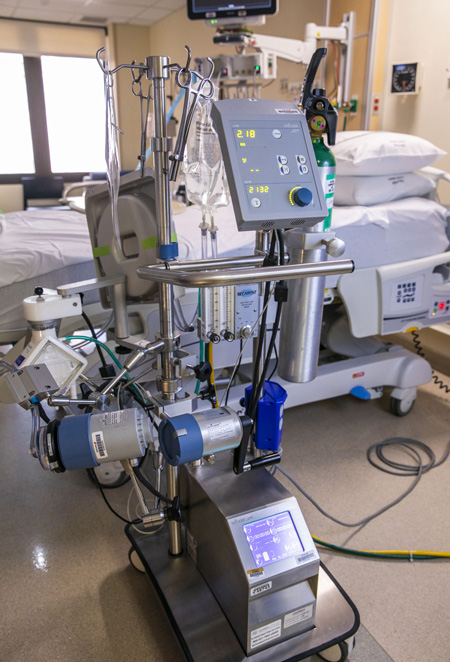What is ECMO?
Extracorporeal membrane oxygenation (ECMO) is a life support machine. People who need ECMO have a severe and life-threatening illness that stops their heart or lungs from working properly. For example, ECMO is used during life-threatening conditions such as severe lung damage from infection, or shock after a massive The ECMO machine replaces the function of the heart and lungs. People who need support from an ECMO machine are cared for in a hospital’s intensive care unit (ICU). Typically, people are supported by an ECMO machine for only a few hours to days

Why is ECMO used?
ECMO is used to help people whose:
■ Lungs cannot provide enough oxygen to the body even when given extra oxygen
■ Lungs cannot get rid of carbon dioxide even with help from a mechanical ventilator
■ Heart cannot pump enough blood to the body ECMO may also be used to support people with heart or lung disease that cannot be cured while they wait for an organ transplant (e.g. new heart and/or lungs).
How does an ECMO machine work?
The ECMO machine is connected to a patient through plastic tubes(cannula). The tubes are placed in large veins and arteries in the legs, neck or chest. The procedure by which a healthcare provider places these tubes in a patient is called cannulation. The ECMO machine pumps blood from the patient’s body to an artificial lung (oxygenator) that adds oxygen to it and removes carbon dioxide. Thus, it replaces the function of the person’s own lungs. The ECMO machine then sends the blood back to the patient via a pump with the same force as the heart, replacing its function.
The ECMO machine is controlled by a person called a perfusionist, or a nurse or respiratory therapist with advanced training called an ECMO specialist. The perfusionist or ECMO specialist will adjust the settings on the machine to give the patient the amount of heart and lung support they need.

What are the risks of being on ECMO?
The healthcare team always aim to avoid any complications that may occur from being on ECMO. Some of the more serious problems that may occur when a patient is on ECMO include:
Bleeding: Because of the blood thinning medication that patients need while on ECMO, they can start bleeding in different parts of their body. This can be a very serious problem if the bleeding happens in their brain, lungs, insertion sites of cannulae or from their stomach.
Kidney Failure: Patients who are on ECMO sometimes do not get enough blood flow to their kidneys. This can cause their kidneys to stop working, known as “acute renal failure”
Infection: The tubes from the ECMO machine go from outside the patient’s body directly into their bloodstream. This increases the risk for infection, because the tubes are a way for germs to enter the body.
How does a person get taken off ECMO?
The ECMO machine supports the person while he or she tries to overcome a disease or injury. If the disease or injury improves, the patient may not need the support of the ECMO machine anymore. The healthcare providers will slowly reduce the amount of support the ECMO machine is providing to see if the patient will be okay .
Reference :
American thoracic society
MED Journal of england
nice info dr
ReplyDeleteThanks for this article sir!
ReplyDelete